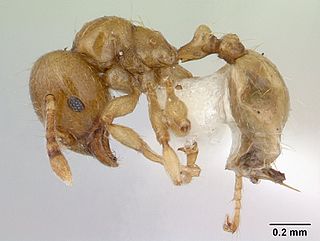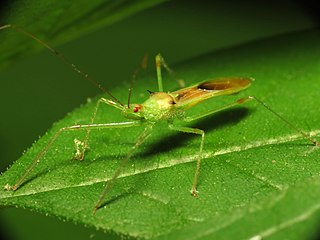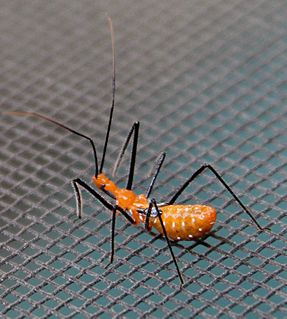
The Reduviidae are a large cosmopolitan family of the order Hemiptera. Among the Hemiptera and together with the Nabidae almost all species are terrestrial ambush predators: most other predatory Hemiptera are aquatic. The main examples of nonpredatory Reduviidae are some blood-sucking ectoparasites in the subfamily Triatominae. Though spectacular exceptions are known, most members of the family are fairly easily recognizable; they have a relatively narrow neck, sturdy build, and formidable curved proboscis. Large specimens should be handled with caution, if at all, because they sometimes defend themselves with a very painful stab from the proboscis.

Allomerus decemarticulatus is an Amazonian ant species found in the tropics of South America. This species is most notable for the workers’ complex and extreme predatory behavior, which involves a symbiosis with both a plant and fungal species. They live in leaf pockets of a host plant species, Hirtella physophora. These leaf pockets are areas inside of the plant between the leaves and the stem. Each colony, which consists of about 1,200 workers, inhabits a single tree; however, the ants are spread among the leaf pockets, with typically 40 workers per pocket. Their diet primarily consists of large insects that are captured on the plant, but they also eat some kinds of food bodies produced by the plant as well as its nectar. They are able to capture their prey, which is much larger than themselves, by constructing a platform that acts as a trap for the unsuspecting prey. The ants hide in the trap and attack when any insect lands on it. This technique is an example of ambush predation.

Asopinae are a subfamily of stink bugs. They are predatory stink bugs that are useful as biological control agents against pests, even against other Pentatomid species, which are all herbivorous.

Zelus is a genus of insects in the family Reduviidae, the assassin bugs. There are currently 60 described species; most occur in Central and South America, and five are found in North America.

The Harpactorinae are a large subfamily of the Reduviidae. About 300 genera and 2,000 species worldwide have been described. Some of the species of the genera Zelus, Pselliopus, Sinea, and Apiomerus are of interest as biological pest control agents.

Zelus luridus, also known as the pale green assassin bug, is a species of assassin bug native to North America. It is the most common Zelus species in the eastern United States. The size ranges from 12.5 to 18 millimetres long. On average, adult females are 16 millimetres (0.63 in) long, while males are 14 millimetres (0.55 in) long. Though the base color is pale green, markings on the back can range from dark brown or red to bright yellow. Nymphs are generally more solid green, wingless, and with narrower bodies than adults. The most reliable feature to distinguish this species from others is the pair of spines on the rear corners of the pronotum. These spines are long on the lighter colored individuals and shorter on ones that are darker. It can also be distinguished by dark bands on the distal ends of the femurs, but these can often be too light to be easily seen. The egg masses, which are laid from late June to August, are conical in shape with a flat top. They are laid on leaves in groups of twenty to fifty and held together with a sticky, brownish material. Their bite is extremely painful.

Harpactorini is a tribe of the Harpactorinae. This group is the most diverse of the entire assassin bug family, with 51 genera recognized in the Neotropical Region and 289 genera and 2003 species overall.
Harpactor angulosus is a species of true bug (Harpactorinae). This assassin bug has been documented preying on caterpillars of the genus Hylesia in Viçosa, Minas Gerais State, Brazil. Caterpillars of this genus are an agricultural pest. H. angulosus, like other species of Harpactorini, has potential as a biological pest control agent.
Pahabengkakia piliceps is a species of true bug (harpactorinae) found in Thailand. This species is apparently a specialist predator of the stingless bee Trigona collina. Larval P. piliceps mimic the bees, and eggs are laid in the bees' hives. Nymphs of P. piliceps were found to occupy the nest entrance and kill returning foraging bees. The assassin bug does not seem to predate other Trigona species, even though they are also present in the area.
Liangcoris is a monotypic genus of assassin bugs, in the subfamily Harpactorinae.

Pselliopus is a common genus of assassin bugs (Reduviidae), in the subfamily Harpactorinae. The genus is restricted to the New World, with 27 species described. Some species, such as Pselliopus barberi, are conspicuous because of their bright coloring and relatively large size. Some species of the genus are of interest as potential biological pest control agents.

Zelus longipes is an assassin bug (Reduviidae) that is a member of the Harpactorinae subfamily. Its distribution ranges include southern North America, Central America, and South America, especially in agroecosystems in Brazil.
Zelus annulosus is an assassin bug found in South America. It frequently associates with Hirtella physophora (Chrysobalanaceae), a plant that houses colonies of plant-ants Allomerus decemarticulatus and provides the ants with nectar.

Zelus renardii, the leaf hopper assassin bug, is a predacious insect contained within tribe Harpactorini. Diurnal and found on both wild and crop plants, Z. renardii has spread from its native habitats in western North and Central America into three other biogeographic regions across the globe.

Sphedanolestes cingulatus is a species of assassin bug belonging to the family Reduviidae, in the subfamily Harpactorinae.
Coranus elegans is a species of assassin bug in the sub family Harpactorinae. It is found in Africa.

Zelus cervicalis is a species of assassin bug in the family Reduviidae. It is found in Central America, North America, and South America.
Zelus tetracanthus, the four-spurred assassin bug, is a species of assassin bug in the family Reduviidae. It is found in the Caribbean Sea, Central America, North America, and South America.
Haeterius zelus is a species of clown beetle in the family Histeridae. It is found in North America.

Epidaus is a genus of assassin bugs with about 25 species mainly distributed mainly in the Oriental Realm with two species which extend into the Palearctic Realm. Most species have a long and narrow body with the pronotum having a posterior margin with raised corners and spiny outgrowths facing outwards. The head a tubercle behind the base of each of the two antennae.










